NRS20002 Clinical Reasoning Case Study: Analysis of Jack's Condition
VerifiedAdded on 2023/04/25
|5
|1079
|229
Case Study
AI Summary
This case study analyzes the post-operative care of a 63-year-old patient named Jack who underwent surgery for left-sided colon cancer. The analysis, conducted by a nursing student, focuses on gathering further information about the patient's condition, identifying immediate and short-term problems, and applying the clinical reasoning cycle to guide diagnosis and treatment. The student proposes physical assessments, diagnostic tests like CT scans and CEA, and addresses immediate issues such as high blood glucose and low blood pressure, along with potential complications like diarrhea, constipation, and calcium/Vitamin D deficiencies. The analysis incorporates relevant literature and research to support the assessment and proposed interventions, emphasizing a holistic approach to patient care and the application of the Levett-Jones clinical reasoning cycle for effective diagnosis and problem-solving.
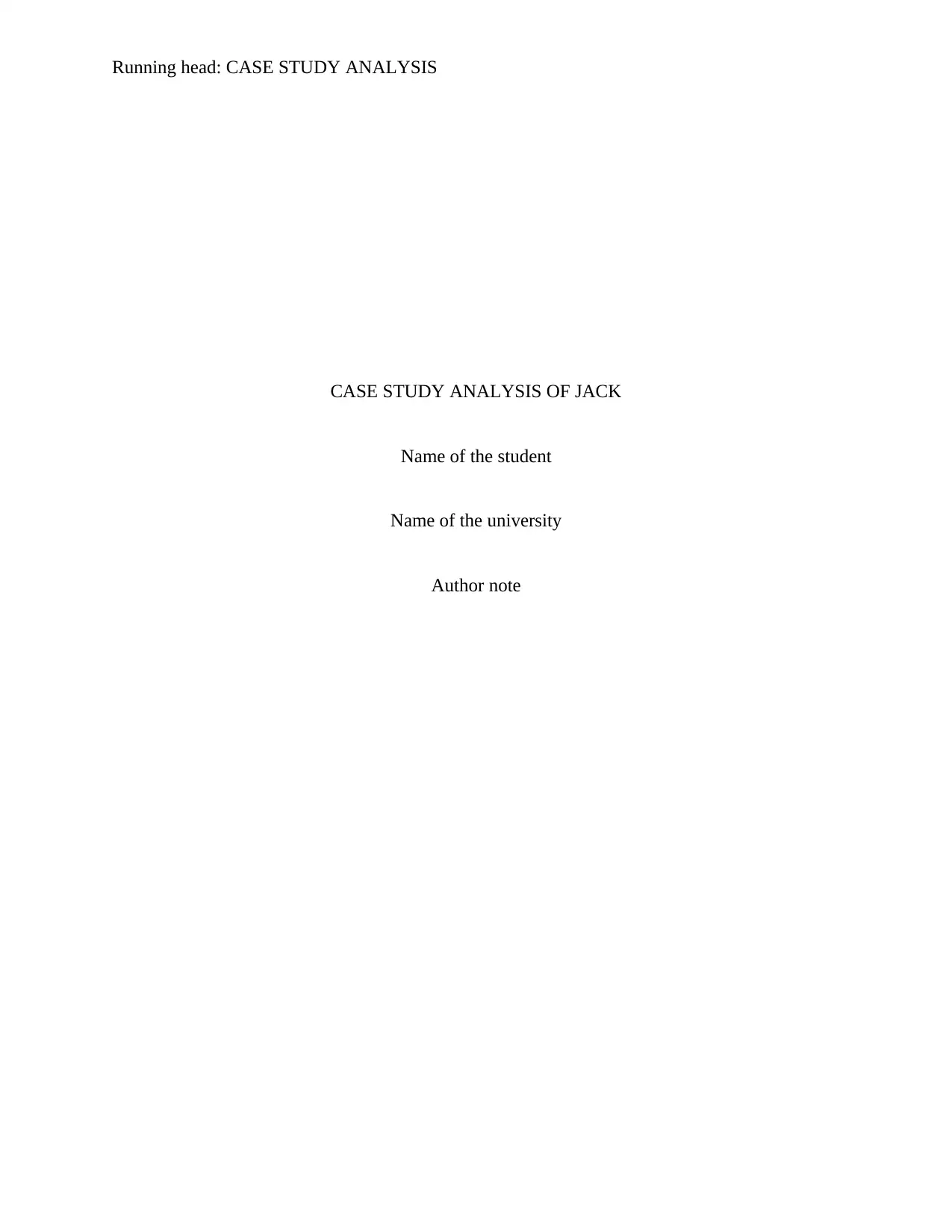
Running head: CASE STUDY ANALYSIS
CASE STUDY ANALYSIS OF JACK
Name of the student
Name of the university
Author note
CASE STUDY ANALYSIS OF JACK
Name of the student
Name of the university
Author note
Paraphrase This Document
Need a fresh take? Get an instant paraphrase of this document with our AI Paraphraser
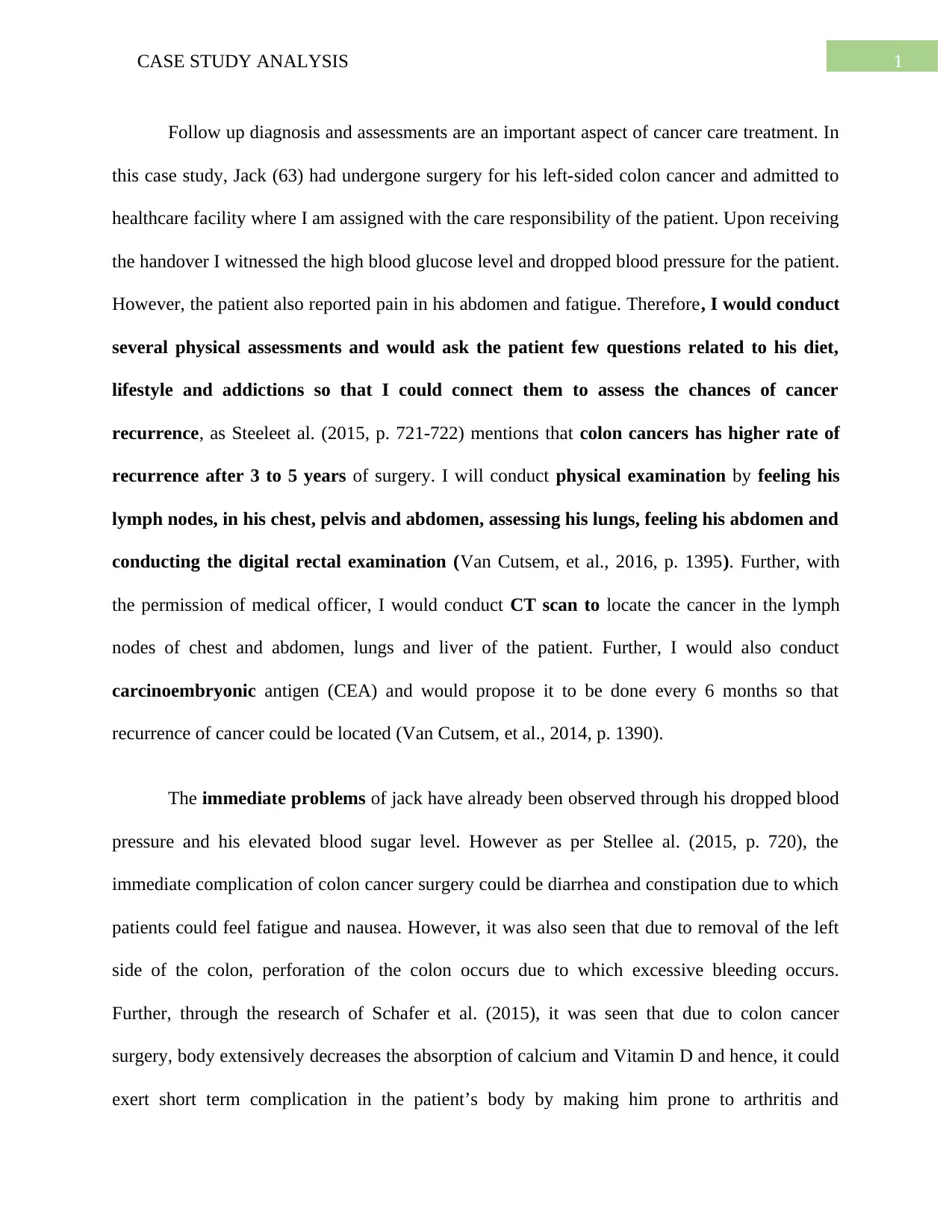
1CASE STUDY ANALYSIS
Follow up diagnosis and assessments are an important aspect of cancer care treatment. In
this case study, Jack (63) had undergone surgery for his left-sided colon cancer and admitted to
healthcare facility where I am assigned with the care responsibility of the patient. Upon receiving
the handover I witnessed the high blood glucose level and dropped blood pressure for the patient.
However, the patient also reported pain in his abdomen and fatigue. Therefore, I would conduct
several physical assessments and would ask the patient few questions related to his diet,
lifestyle and addictions so that I could connect them to assess the chances of cancer
recurrence, as Steeleet al. (2015, p. 721-722) mentions that colon cancers has higher rate of
recurrence after 3 to 5 years of surgery. I will conduct physical examination by feeling his
lymph nodes, in his chest, pelvis and abdomen, assessing his lungs, feeling his abdomen and
conducting the digital rectal examination (Van Cutsem, et al., 2016, p. 1395). Further, with
the permission of medical officer, I would conduct CT scan to locate the cancer in the lymph
nodes of chest and abdomen, lungs and liver of the patient. Further, I would also conduct
carcinoembryonic antigen (CEA) and would propose it to be done every 6 months so that
recurrence of cancer could be located (Van Cutsem, et al., 2014, p. 1390).
The immediate problems of jack have already been observed through his dropped blood
pressure and his elevated blood sugar level. However as per Stellee al. (2015, p. 720), the
immediate complication of colon cancer surgery could be diarrhea and constipation due to which
patients could feel fatigue and nausea. However, it was also seen that due to removal of the left
side of the colon, perforation of the colon occurs due to which excessive bleeding occurs.
Further, through the research of Schafer et al. (2015), it was seen that due to colon cancer
surgery, body extensively decreases the absorption of calcium and Vitamin D and hence, it could
exert short term complication in the patient’s body by making him prone to arthritis and
Follow up diagnosis and assessments are an important aspect of cancer care treatment. In
this case study, Jack (63) had undergone surgery for his left-sided colon cancer and admitted to
healthcare facility where I am assigned with the care responsibility of the patient. Upon receiving
the handover I witnessed the high blood glucose level and dropped blood pressure for the patient.
However, the patient also reported pain in his abdomen and fatigue. Therefore, I would conduct
several physical assessments and would ask the patient few questions related to his diet,
lifestyle and addictions so that I could connect them to assess the chances of cancer
recurrence, as Steeleet al. (2015, p. 721-722) mentions that colon cancers has higher rate of
recurrence after 3 to 5 years of surgery. I will conduct physical examination by feeling his
lymph nodes, in his chest, pelvis and abdomen, assessing his lungs, feeling his abdomen and
conducting the digital rectal examination (Van Cutsem, et al., 2016, p. 1395). Further, with
the permission of medical officer, I would conduct CT scan to locate the cancer in the lymph
nodes of chest and abdomen, lungs and liver of the patient. Further, I would also conduct
carcinoembryonic antigen (CEA) and would propose it to be done every 6 months so that
recurrence of cancer could be located (Van Cutsem, et al., 2014, p. 1390).
The immediate problems of jack have already been observed through his dropped blood
pressure and his elevated blood sugar level. However as per Stellee al. (2015, p. 720), the
immediate complication of colon cancer surgery could be diarrhea and constipation due to which
patients could feel fatigue and nausea. However, it was also seen that due to removal of the left
side of the colon, perforation of the colon occurs due to which excessive bleeding occurs.
Further, through the research of Schafer et al. (2015), it was seen that due to colon cancer
surgery, body extensively decreases the absorption of calcium and Vitamin D and hence, it could
exert short term complication in the patient’s body by making him prone to arthritis and
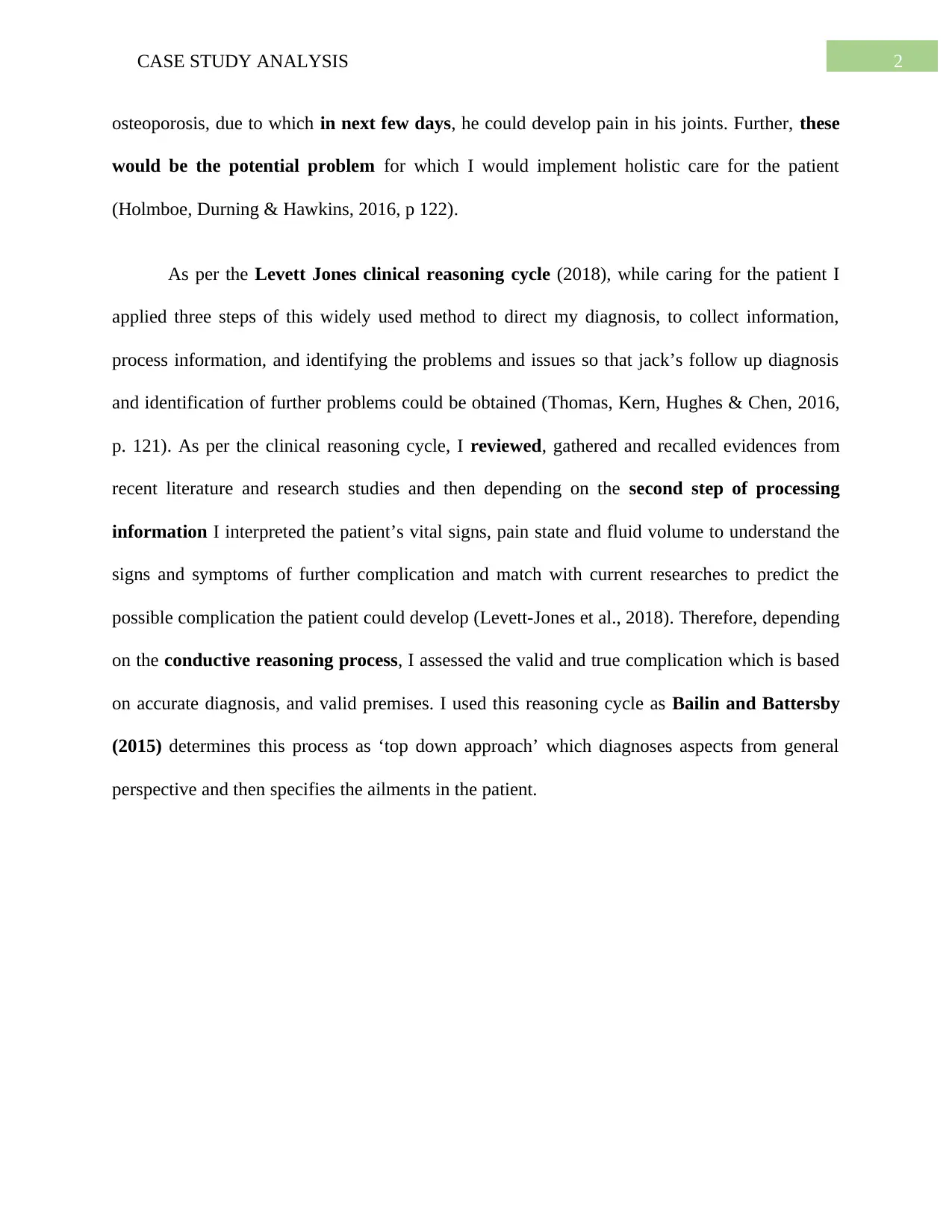
2CASE STUDY ANALYSIS
osteoporosis, due to which in next few days, he could develop pain in his joints. Further, these
would be the potential problem for which I would implement holistic care for the patient
(Holmboe, Durning & Hawkins, 2016, p 122).
As per the Levett Jones clinical reasoning cycle (2018), while caring for the patient I
applied three steps of this widely used method to direct my diagnosis, to collect information,
process information, and identifying the problems and issues so that jack’s follow up diagnosis
and identification of further problems could be obtained (Thomas, Kern, Hughes & Chen, 2016,
p. 121). As per the clinical reasoning cycle, I reviewed, gathered and recalled evidences from
recent literature and research studies and then depending on the second step of processing
information I interpreted the patient’s vital signs, pain state and fluid volume to understand the
signs and symptoms of further complication and match with current researches to predict the
possible complication the patient could develop (Levett-Jones et al., 2018). Therefore, depending
on the conductive reasoning process, I assessed the valid and true complication which is based
on accurate diagnosis, and valid premises. I used this reasoning cycle as Bailin and Battersby
(2015) determines this process as ‘top down approach’ which diagnoses aspects from general
perspective and then specifies the ailments in the patient.
osteoporosis, due to which in next few days, he could develop pain in his joints. Further, these
would be the potential problem for which I would implement holistic care for the patient
(Holmboe, Durning & Hawkins, 2016, p 122).
As per the Levett Jones clinical reasoning cycle (2018), while caring for the patient I
applied three steps of this widely used method to direct my diagnosis, to collect information,
process information, and identifying the problems and issues so that jack’s follow up diagnosis
and identification of further problems could be obtained (Thomas, Kern, Hughes & Chen, 2016,
p. 121). As per the clinical reasoning cycle, I reviewed, gathered and recalled evidences from
recent literature and research studies and then depending on the second step of processing
information I interpreted the patient’s vital signs, pain state and fluid volume to understand the
signs and symptoms of further complication and match with current researches to predict the
possible complication the patient could develop (Levett-Jones et al., 2018). Therefore, depending
on the conductive reasoning process, I assessed the valid and true complication which is based
on accurate diagnosis, and valid premises. I used this reasoning cycle as Bailin and Battersby
(2015) determines this process as ‘top down approach’ which diagnoses aspects from general
perspective and then specifies the ailments in the patient.
⊘ This is a preview!⊘
Do you want full access?
Subscribe today to unlock all pages.

Trusted by 1+ million students worldwide
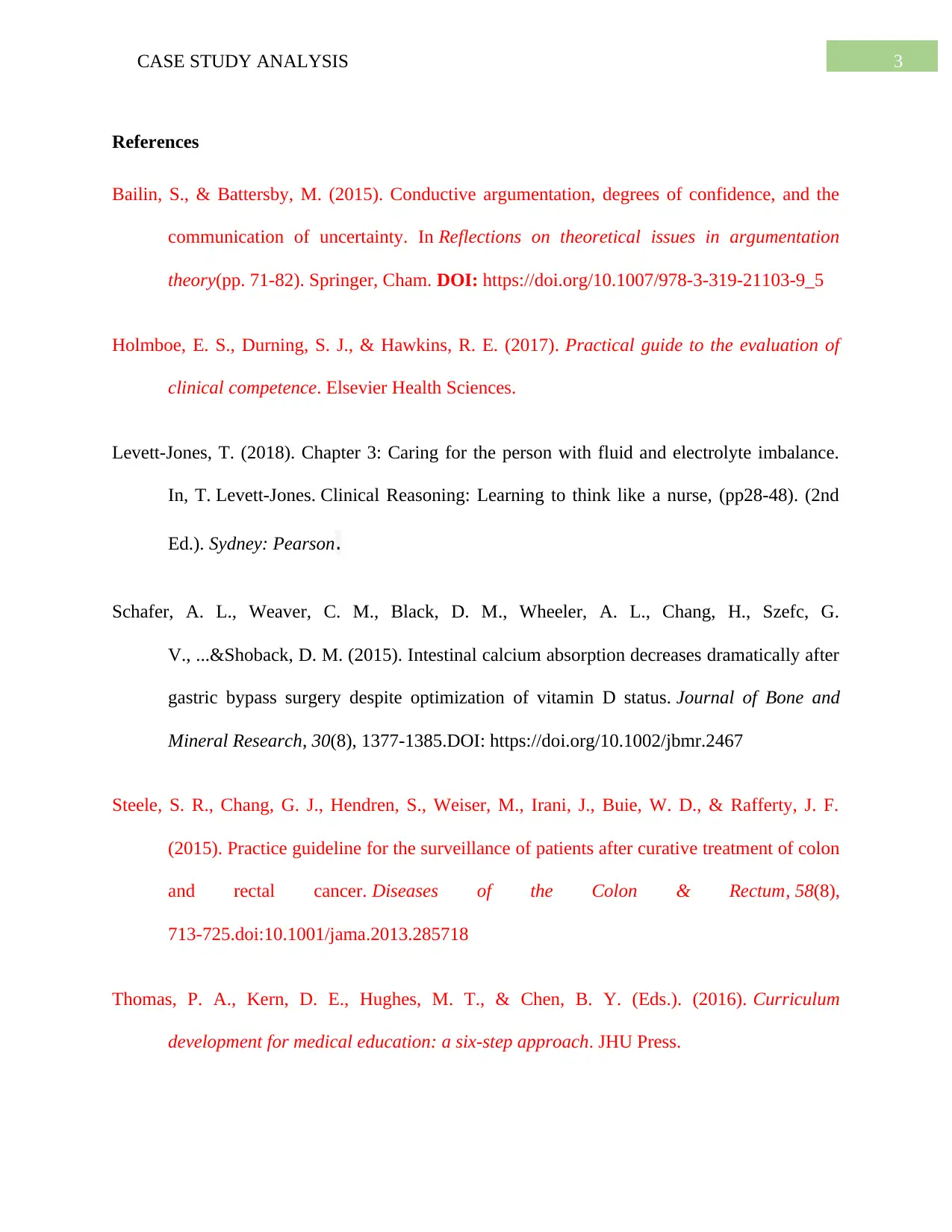
3CASE STUDY ANALYSIS
References
Bailin, S., & Battersby, M. (2015). Conductive argumentation, degrees of confidence, and the
communication of uncertainty. In Reflections on theoretical issues in argumentation
theory(pp. 71-82). Springer, Cham. DOI: https://doi.org/10.1007/978-3-319-21103-9_5
Holmboe, E. S., Durning, S. J., & Hawkins, R. E. (2017). Practical guide to the evaluation of
clinical competence. Elsevier Health Sciences.
Levett-Jones, T. (2018). Chapter 3: Caring for the person with fluid and electrolyte imbalance.
In, T. Levett-Jones. Clinical Reasoning: Learning to think like a nurse, (pp28-48). (2nd
Ed.). Sydney: Pearson.
Schafer, A. L., Weaver, C. M., Black, D. M., Wheeler, A. L., Chang, H., Szefc, G.
V., ...&Shoback, D. M. (2015). Intestinal calcium absorption decreases dramatically after
gastric bypass surgery despite optimization of vitamin D status. Journal of Bone and
Mineral Research, 30(8), 1377-1385.DOI: https://doi.org/10.1002/jbmr.2467
Steele, S. R., Chang, G. J., Hendren, S., Weiser, M., Irani, J., Buie, W. D., & Rafferty, J. F.
(2015). Practice guideline for the surveillance of patients after curative treatment of colon
and rectal cancer. Diseases of the Colon & Rectum, 58(8),
713-725.doi:10.1001/jama.2013.285718
Thomas, P. A., Kern, D. E., Hughes, M. T., & Chen, B. Y. (Eds.). (2016). Curriculum
development for medical education: a six-step approach. JHU Press.
References
Bailin, S., & Battersby, M. (2015). Conductive argumentation, degrees of confidence, and the
communication of uncertainty. In Reflections on theoretical issues in argumentation
theory(pp. 71-82). Springer, Cham. DOI: https://doi.org/10.1007/978-3-319-21103-9_5
Holmboe, E. S., Durning, S. J., & Hawkins, R. E. (2017). Practical guide to the evaluation of
clinical competence. Elsevier Health Sciences.
Levett-Jones, T. (2018). Chapter 3: Caring for the person with fluid and electrolyte imbalance.
In, T. Levett-Jones. Clinical Reasoning: Learning to think like a nurse, (pp28-48). (2nd
Ed.). Sydney: Pearson.
Schafer, A. L., Weaver, C. M., Black, D. M., Wheeler, A. L., Chang, H., Szefc, G.
V., ...&Shoback, D. M. (2015). Intestinal calcium absorption decreases dramatically after
gastric bypass surgery despite optimization of vitamin D status. Journal of Bone and
Mineral Research, 30(8), 1377-1385.DOI: https://doi.org/10.1002/jbmr.2467
Steele, S. R., Chang, G. J., Hendren, S., Weiser, M., Irani, J., Buie, W. D., & Rafferty, J. F.
(2015). Practice guideline for the surveillance of patients after curative treatment of colon
and rectal cancer. Diseases of the Colon & Rectum, 58(8),
713-725.doi:10.1001/jama.2013.285718
Thomas, P. A., Kern, D. E., Hughes, M. T., & Chen, B. Y. (Eds.). (2016). Curriculum
development for medical education: a six-step approach. JHU Press.
Paraphrase This Document
Need a fresh take? Get an instant paraphrase of this document with our AI Paraphraser
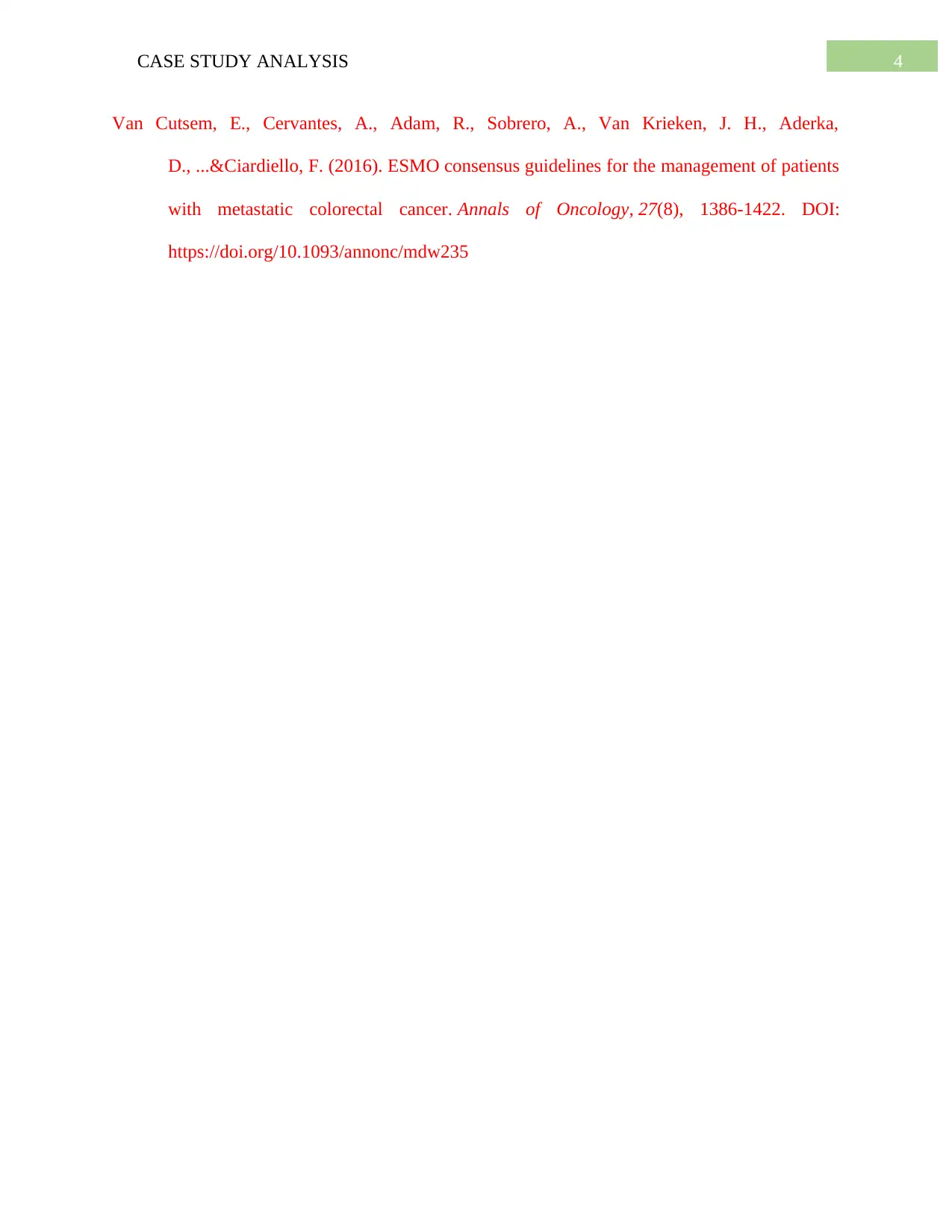
4CASE STUDY ANALYSIS
Van Cutsem, E., Cervantes, A., Adam, R., Sobrero, A., Van Krieken, J. H., Aderka,
D., ...&Ciardiello, F. (2016). ESMO consensus guidelines for the management of patients
with metastatic colorectal cancer. Annals of Oncology, 27(8), 1386-1422. DOI:
https://doi.org/10.1093/annonc/mdw235
Van Cutsem, E., Cervantes, A., Adam, R., Sobrero, A., Van Krieken, J. H., Aderka,
D., ...&Ciardiello, F. (2016). ESMO consensus guidelines for the management of patients
with metastatic colorectal cancer. Annals of Oncology, 27(8), 1386-1422. DOI:
https://doi.org/10.1093/annonc/mdw235
1 out of 5
Related Documents
Your All-in-One AI-Powered Toolkit for Academic Success.
+13062052269
info@desklib.com
Available 24*7 on WhatsApp / Email
![[object Object]](/_next/static/media/star-bottom.7253800d.svg)
Unlock your academic potential
Copyright © 2020–2025 A2Z Services. All Rights Reserved. Developed and managed by ZUCOL.





